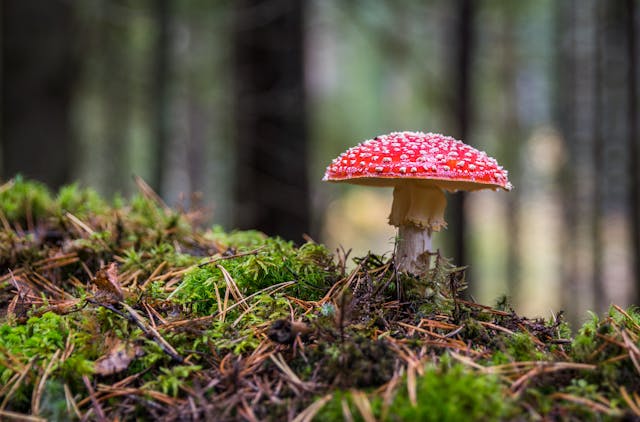
Why are many mushrooms dangerous? This is a little bit tricky because not all mushrooms are dangerous, but a lot of them contain toxins that can be harmful or fatal. A lot of plants are also toxic, but they can have edible parts. If you get lost in the wild, the general advice is to avoid eating any mushrooms unless you know exactly what you are doing. A lot of mushrooms are either mildly toxic or fatally toxic, so your chances of finding a mushroom that is safely edible are not good enough to make it worth the risk.
What is a mushroom? Mushrooms are the “fleshy, spore-bearing fruiting body of a fungus, typically produced above ground.” The part of the mushroom we can see is only a small part of the whole fungus. The fungi form and spread underground, but they have to produce mushrooms to reproduce. They are not plants because they do not photosynthesize. They are heterotrophs, which means they get their energy from other organisms. Plants are autotrophs because they can make energy from sunlight. Mushrooms have to feed on animal waste, plant matter, and other organic materials to produce their energy. They are also different to plants in their cell structure. Plants are made of rigid cellulose and mushrooms are made of chitin and glucan, which are polysaccharides. Polysaccharides are chains of carbohydrates. They contain a lot of fluid, which gives them their shape. Mushrooms tend to grow quickly, once the roots have put them up. The more fluid they have available, the faster they grow. This is why we use the word “mushrooming” to describe something that is increasing quickly.
There are at least 10,000 identified types of mushrooms and there are probably many more that haven’t been found yet. Out of these, according to mushroomthejournal.com, 4% are the good ones that we eat, 25% are edible, but not very tasty, 50% are too tough to chew or indigestible, 20% will make you sick, and 1% will kill you.
What makes a mushroom dangerous? A lot of fungi produce something called mycotoxin. There are hundreds of different mycotoxins and some of them are far more dangerous to us than others. That is why some mushrooms make you sick and some mushrooms kill you. Mycotoxins are produced when the fungi metabolizes the organic matter they use for food. Nobody knows the reason why some fungi produce mycotoxins, but it could be to do with the way they spread their spores and the bacteria and organisms they compete with.
Fungi live by breaking down decomposing organic matter. There are a lot of organisms and bacteria that also do the same thing. One theory of mycotoxin production is that it kills off the competition and leaves the poisonous fungi with more food.
The second theory is down to the way they spread their spores. The reason fungi produce mushrooms is to be able to spread their spores. When the temperature is suitable and there is enough water, fungi produce mushrooms, and they make a stem with a large cap. On the underside of the cap, they have cavities that are a range of different shapes, but they all contain spores. There are then three ways that the mushroom spreads the spores. The first way is to be eaten by some animal. In the same way as seeds in edible fruit, the spores are coated so that they will pass unharmed through an animal’s digestive system, and they can start to grow when the animal passes them. Mushrooms with this dispersal system are obviously not toxic. The second system is to attract insects to carry the spores away. These mushrooms usually are bioluminescent and either toxic or too hard to eat because they need to survive long enough for the insects to come. The third type of mushroom just drops its spores, and they are carried away on the wind. This type of mushroom are also toxic or too hard to eat because they need to stay where they are long enough to release their spores. A lot of insects, snails, and animals want to eat mushrooms, but they very quickly learn to avoid the toxic ones.
Interestingly, a lot of plants are also toxic to us. Plants have evolved along the same lines as mushrooms. If plants want to be eaten, they are not toxic. If they don’t want to be eaten, they are toxic. Although, sometimes, those toxins are things we look for. Caffeine and nicotine are both toxins that plants produce to stop insects from eating them.
To close, the world’s deadliest mushroom is the Amanita phalloides, commonly known as the death cap mushroom. It produces three different mycotoxins and the most powerful of the three toxins prevents our bodies from synthesizing proteins, which means we basically shut down and die. It takes between four and nine days to kill a person, and they die because of multiple organ failure. If caught early enough, there are several methods which can potentially stop the body from taking in the toxins, but there is generally no antidote or cure beyond a liver transplant. And this is what I learned today.
Photo by Egor Kamelev: https://www.pexels.com/photo/closeup-photo-of-red-and-white-mushroom-757292/
Sources
https://en.wikipedia.org/wiki/Chitin-glucan_complex
https://en.wikipedia.org/wiki/Mushroom_poisoning
https://en.wikipedia.org/wiki/Mycotoxin
https://theconversation.com/why-are-some-mushrooms-poisonous-160151
https://www.mushroomthejournal.com/greatlakesdata/TopTen/Quest19.html
https://en.wikipedia.org/wiki/Mushroom
https://www.who.int/news-room/fact-sheets/detail/mycotoxins
https://pmc.ncbi.nlm.nih.gov/articles/PMC164220
https://bcmj.org/articles/worlds-most-poisonous-mushroom-amanita-phalloides-growing-bc

Pingback: #2 Where did ketchup come from? What did it have to do with mushrooms?
Pingback: #890 Why are truffles so expensive?
Pingback: What caused the Irish potato famine?
Pingback: Why do planes use halon fire extinguishers?
Pingback: #535 Why is a broken neck fatal?